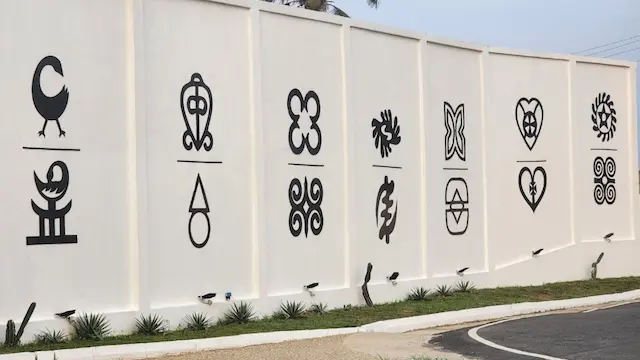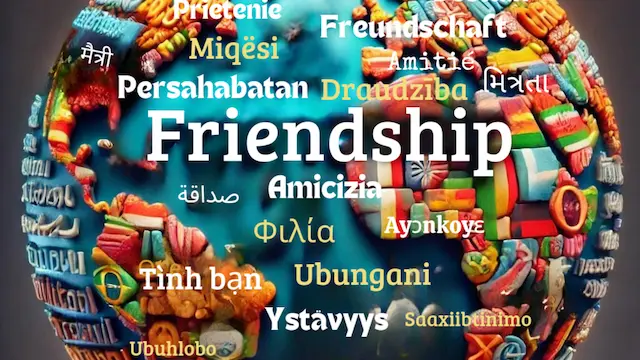Adinkra Symbols of Ghana: Discover the Meaning of Cultural Symbols Around You

Have you ever wondered what some cultural symbols displayed around you mean? We often see them and appreciate their beauty, but rarely pause to ask about their deeper significance. Adinkra symbols from Ghana are a perfect example. These designs, originating from the Akan people, carry deep meanings and have been passed down through generations, reflecting the wisdom and beliefs of their culture.

The Origins and History of Adinkra Symbols
Cultural Background of the Akan People
The Akan people, primarily located in Ghana, have a rich cultural heritage that includes creating symbols to convey important messages. Adinkra symbols likely originated with the Gyaman people of present-day Côte d'Ivoire (“Côte d'Ivoire” is the official name in French, while “Ivory Coast” is the English translation) before migrating to Ghana. Initially reserved for royalty and spiritual leaders, these symbols became widespread in Akan society, symbolizing cultural values and beliefs.
The Birth of Adinkra Symbols
Adinkra symbols are believed to have originated with the Gyaman people, who lived in what is now Côte d'Ivoire before migrating to Ghana in the 17th century. Initially, these symbols were used on cloth worn by royalty and spiritual leaders during significant ceremonies and rituals, serving as a medium to express timeless wisdom and cultural values. Although the symbols date back to the early 19th century, their origins and significance likely extend further into the past. Over time, the use of Adinkra symbols expanded beyond the elite to the wider Akan community, becoming an integral part of their cultural expression.

Adinkra symbols are created using a special dye made from the bark of the Badie tree. The symbols are stamped onto cloth with carved calabash stamps, allowing the dye to be absorbed into the fabric. The resulting cloth is then used to make clothing, bags, and other items. Today, Adinkra symbols are widely used for decoration and communication, appearing on everything from wall art and pottery to tattoos and corporate logos. In our home, Adinkra symbols are quite prominent in various forms. Honestly, until the kids started asking about their meanings, I didn’t know many of them myself.
Role in Akan Society and Traditions
Adinkra symbols communicate messages about life, death, and the afterlife. They are used to decorate buildings, pottery, and objects, reflecting cultural identity. Today, these symbols are seen everywhere, from traditional cloth to everyday items, symbolizing a deep connection to heritage.
Decoding the Meanings Behind Common Adinkra Symbols
Each Adinkra symbol holds a unique meaning. These symbols, deeply rooted in spiritual and philosophical beliefs, are more than artistic designs—they reflect the Akan worldview. We will explore the meanings behind some of the most common Adinkra symbols.
Gye Nyame: The Supremacy of God
The Gye Nyame symbol is one of the most popular Adinkra symbols and represents the supremacy of God. The symbol features a circle with a line through it, which represents the omnipotence and omnipresence of God. The phrase “Gye Nyame” translates to “except for God” and emphasizes the importance of God in Ghanaian culture.


Sankofa: Learning from the Past
The Sankofa symbol is another popular Adinkra symbol that represents the importance of learning from the past. The symbol features a bird with its head turned backward, symbolizing the idea of looking back to move forward. The Sankofa symbol is often used to remind people of the importance of learning from their past mistakes to create a better future.
Fofo: Democracy and Unity
The Fofo symbol is a unique Adinkra symbol that represents democracy and unity. The symbol features a crossed pair of swords, which represent the need for unity and cooperation. The symbol is often used to remind people of the importance of working together to achieve a common goal.

The Spiritual Significance of Adinkra Symbols
Adinkra symbols are not only cultural markers but also hold profound spiritual meanings that reflect the Akan people's beliefs. These symbols have been deeply intertwined with the spiritual life of the Akan community, often used by royalty, priests, and spiritual leaders during ceremonies that hold significant spiritual importance, such as funerals and sacred rituals.
The spiritual aspect of Adinkra symbols is evident in how they are used to convey concepts related to the divine, the soul, and the afterlife. For instance:
- Gye Nyame: Meaning “Except for God.” It represents the omnipotence and supremacy of God, emphasizing the Akan belief in a higher power governing all aspects of life.
- Nyame Dua: Meaning “tree of God,” this symbol is associated with sacred altars and places of worship, signifying the importance of spiritual reflection and communion with the divine.
- Sunsum: This symbol represents the “spirit” or “soul,” reflecting the Akan belief in a spiritual essence that transcends the physical body, highlighting the spiritual dimension of human existence.

Through these symbols, the Akan people express their spiritual values and beliefs, using visual art as a form of spiritual communication and reflection. Understanding these spiritual meanings allows for a deeper appreciation of how the Akan people view life, the divine, and the journey beyond the physical world.
Other Notable Adinkra Symbols
There are many other Adinkra symbols, each with its own unique meaning. Some notable symbols include:
- Adinkrahene: The chief of Adinkra symbols, representing greatness and charisma.
- Akoma Ntoso: The symbol of the heart, representing patience, tolerance, and faithfulness.
- Nkyinkyim: The symbol of the twisted or crookedness, representing the twists and turns of life.
Importance of Colors and Patterns
Adinkra symbols are often featured in art, clothing, and architecture. While the symbols themselves are distinct designs, the cloths and materials they are printed on can have different colors, each carrying its own significance. For example, in Akan culture, the color red is often associated with death and mourning, while white represents purity and peace.

Use in Art, Clothing, and Architecture
Adinkra symbols are an essential part of Ghanaian culture and are often used in art, clothing, and architecture. Adinkra cloth is a popular fabric in Ghana and is often used to make clothing and other textiles. Adinkra symbols can also be found in architecture, such as in the design of buildings and monuments.
Cultural and Philosophical Depth of Adinkra Symbols
Reflecting Ghanaian Values and Beliefs
Adinkra symbols hold a special place in Ghanaian culture and are deeply rooted in the country's values and beliefs. These symbols are not just mere decorations; they carry deep meaning and significance. Each symbol has a unique story and message that reflects the collective wisdom of the Akan people. They are a testament to the rich cultural heritage of Ghana and a source of pride for its people.
Influence on Literature, Proverbs, and Oral Traditions
Adinkra symbols have had a profound influence on Ghanaian literature, proverbs, and oral traditions. These symbols are often used to convey important messages and lessons in various forms of storytelling, becoming integral to the country's oral tradition. For instance, symbols like Sankofa (“Return and get it”) and Dwennimmen (“Ram's horns,” representing strength and humility) are commonly referenced to teach children about the values and beliefs of their ancestors.

Adinkra symbols have also been incorporated into literature and proverbs, adding depth and meaning to these works. In modern times, they continue to inspire contemporary storytelling, appearing in literature, plays, and even films, reflecting their enduring relevance. They are used in educational settings to impart moral lessons and social values, ensuring that the wisdom of past generations remains alive in today's youth.
The integration of Adinkra symbols in storytelling plays a significant role in cultural preservation and revival, maintaining a connection to Ghanaian heritage in a rapidly changing world. These symbols have even crossed borders, influencing people globally who appreciate and adapt them to their own cultural narratives, showcasing their universal appeal and adaptability.
Promoting Unity, Wisdom, and Personal Growth
Adinkra symbols promote unity, wisdom, and personal growth. These symbols are not just a representation of Ghanaian culture but are also a source of inspiration for individuals seeking personal growth and self-improvement. Each symbol has a unique message that can be applied to various aspects of life. By embracing these symbols, you can gain a deeper understanding of yourself and the world around you.
Adinkra symbols reflect the values and beliefs of the Akan people and have had a profound influence on literature, proverbs, and oral traditions. By embracing these symbols, you can gain a deeper understanding of yourself and the world around you, promoting unity, wisdom, and personal growth.
Preserving and Promoting Adinkra Symbolism
Efforts in Preservation and Education
Efforts to preserve and promote Adinkra symbolism are ongoing in Ghana and around the world. In Ghana, various government bodies, such as the Ministry of Tourism, Arts, and Culture, alongside the National Commission on Culture, work to preserve and promote the country's rich cultural heritage, including the traditions surrounding Adinkra symbols. These efforts are part of broader initiatives to safeguard Ghanaian cultural practices and ensure they are passed down through generations.
In addition to government involvement, many private organizations, cultural centers, and individuals contribute to preserving and promoting Adinkra symbolism. These efforts include establishing cultural centers and museums, organizing workshops, and creating educational programs and resources that focus on the history and meaning of Adinkra symbols. Local artisans also play a crucial role in sustaining the tradition by continuing to produce Adinkra cloth and incorporating the symbols into contemporary art and fashion.
When we visited Ghana as a family, we noticed that Adinkra symbols were everywhere—on buildings, menus, taxis, and so much more. Nowhere was this more evident than at the Manhyia Palace, where the symbols were prominently displayed, serving as a constant reminder of the rich cultural heritage and deep-rooted traditions of the Akan people.

Modern Cultural Significance and Global Influence
In modern times, Adinkra symbols have found a place in global fashion, art, and design. Their appeal extends beyond Ghana, inspiring artists worldwide. Social media and digital platforms further amplify their visibility, making these symbols a part of global cultural narratives.
Opportunities for Cultural Exchange
Adinkra symbols facilitate cultural exchange, providing a medium through which diverse cultures can share values. Educational experiences, such as workshops and museum visits, allow people to connect with Ghanaian heritage and appreciate its global influence.
Significance and Depth of Adinkra Symbols
Adinkra symbols are a testament to the creativity and ingenuity of the Ghanaian people. They represent important virtues such as strength, courage, and wisdom, and serve as a reminder of the importance of community, family, and tradition.

Exploring and Appreciating Adinkra Symbolism
By exploring Adinkra symbolism, we gain a deeper appreciation for the complexity and richness of Ghanaian culture. These symbols offer a unique perspective on life, reflecting values, beliefs, and philosophies that have been passed down through generations.
Studying Adinkra symbols allows us to connect more deeply with our own values and beliefs while gaining a greater understanding of the diversity of cultures and traditions around us. By engaging with these symbols through learning, discussions, and creative expressions, we not only celebrate Ghanaian heritage but also deepen our cultural awareness and appreciation.
Enduring Legacy and Modern Relevance
The legacy of Adinkra symbols continues to thrive in Ghana and beyond. These symbols have a modern relevance that extends far beyond Ghana's borders. They are used in fashion, art, and design around the world, and have become a symbol of African identity and pride.
Remember that these symbols are more than just decorative motifs. They represent a rich cultural heritage and a deep well of wisdom and understanding. By exploring and appreciating Adinkra symbolism, we take important steps towards understanding the complexity and diversity of the world around us.
IF THIS POST RESONATES WITH YOU, CONSIDER EXPLORING MORE OF OUR WEBSITE AND PINNING ONE OF THE IMAGES BELOW!
Thank you for your support.








